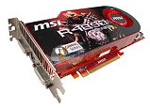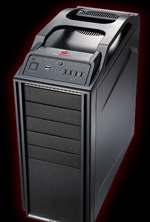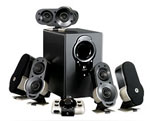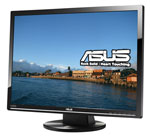Performance Midrange Common Components
While AMD and Intel architectures differ in sockets and sometimes memory configurations, more is the same than not with the two systems. For that reason the Intel and AMD value midrange systems share a number of common components.
 |
If you refer to the recent launch article on the ATI 4890 and NVIDIA GTX 275, you will find these two cards were initially the new choices for the $250 price point. Since then the very popular ATI 4890 has seen tremendous price competition among those selling the card. As a result, an overclocked 4890 can be had for $170 today after $30 rebate. While the GTX 275 performs similarly, it remains around the $250 selling price, with an occasional rebate pushing the price near $200. That is the reason the MSI 4890 OC is the video card choice for both performance midrange systems.
If you prefer NVIDIA cards or NVIDIA drivers, the GTX 275 is an easy substitute in either system. Either card will do the job well and you can shop based on price. The edge goes to the ATI 4890 in the resolutions you will likely run (1920x1200 or lower) with a 27" or smaller display. If you have a 30" monitor, the GTX 275 performs a bit better at those super high resolutions.
 |
The case receives a significant upgrade with the selection of the unique Cooler Master Storm Scout mid-tower case. The Scout has many endearing features, but we would point out the unique rear cutout behind the CPU on the motherboard tray. That makes it possible to install many "through-the-board" aftermarket CPU heatsinks without removing the motherboard. It's a truly clever and useful design element, and we'd like to see more cases support such a feature. The top-mount handle and quiet, effective cooling are also big pluses. Some also want a unique appearance and the Storm Scout delivers with its red LED glow in a distinctive looking case.
Alternates are the Antec Nine Hundred at about the same price and the Antec 902 or Cooler Master Storm Sniper at $160. Both alternatives are very popular with system builders and buyers praise the build quality of both cases.
 |
AnandTech and many other review sites have praised the solid construction, performance, and value of Corsair power supplies. It should come as no surprise that the Corsair 750TX is the choice to power either performance midrange system. The power supply is SLI Ready and CrossFire Ready, 80 PLUS Certified, and Core i7 ready. Power is delivered to a single 60A 12V rail for those looking for that feature and finding it hard to come by at a reasonable price. With a $20 rebate the final cost is $100, which is a great value for a PSU with these specifications, features, and performance reputation.
Most of our editors consider the onboard audio of motherboards to be more than adequate for even gaming these days. That is why we have not chosen a sound card for the performance midrange system. If you want more than onboard surround sound then we recommend the Auzentech X-Fi Forte 7.1 for serious gaming at $140. HTPC users will find much to like in the ASUS Xonar HDAV 1.3 Slim. Other good choices are the ASUS Xonar Essence STX for music, in particular for serious headphone users, or the HT Omega Claro Halo - both run about $200. If you are looking for a good general purpose onboard audio upgrade the HT Omega Striker 7.1 should fit your needs at around $90.
 |
The optical drive for a performance midrange system needs the ability to play Blu-Ray disks. A new model was chosen here with the faster 8X BD read speeds, the LG CH08LS10 Blu-Ray/DVD combo drive. In addition to 8X BD and BD dual-layer playback, you can burn DVDs as fast as 16X single-layer or 12X DL. It cannot, however, burn 25GB/50GB Blu-Ray disks. Adding that capability increases the cost to around $200 to $250. BD burners like the $200 LITE-ON 4X BD-R SATA burner or the $230 LG GGW-H20LK 6X Blu-ray burner are good choices.
 |
Speakers have been upgraded to the Logitech G51 155W RMS 5.1 surround sound speakers. The Logitech rebate has ended, but you can still find the G51 for as little as $120 if you shop, which makes the G51 an excellent value.
 |
The LCD display resolution maintains the 1920 horizontal pixels of 1080p displays but moves to a 26" WUXGA display with a 1200 pixel height. Whatever the minor resolution differences the size of the monitor is increased to a nominal 26" so everything on screen is a little larger (0.292mm pixel pitch). The ASUS VW266H 25.5" HDMI widescreen provides the preferred HDMI input, as well as DVI and an analog VGA port. Panel speed is rated at an incredible 2ms, but we have found most current LCD panels perform similarly and the speed rating does not really guarantee very much. The ASUS monitor provides a large sharp image, good colors, and fast panel speed at a very good price of $300 after rebate. It comes with DVI and VGA cables, but if you plan to connect with HDMI you will need to buy an HDMI cable.
As most readers are aware, LCD panels have been going to cheaper panel technologies and generally declining in image quality. Despite that fact, most buyers are reporting that they are pleased with current LCD screens. It you have a need for exceptional color or yours is a mission-critical graphics task, you may want to look at the HP LP2475w 24" 1920x1200 monitor. This HP monitor is likely the best quality 24" monitor you can buy today, with superior panel technology (S-IPS) and image quality likely to satisfy graphics professionals.
The remaining components are the same as our value systems. The hard drive remains a 1TB WD. The Microsoft OEM keyboard and optical mouse provide input and Vista Home Premium OEM runs the system. For more information on these components you can refer to descriptions on p.3.
 |
In response to those who have asked for SSD recommendations, it is possible to do so based on the months of research and testing performed on SSD drives at AnandTech. For more information on SSD test results please see our SSD Anthology and our SSD update. As we recently reported, you should be on the lookout for further price reductions expected in the next few weeks. The short summary is that the new Intel X25-M G2 SSDs are the top performers, but the price-reduced Indilinx options like the OCZ Vertex and OCZ Agility are viable competitors.










71 Comments
View All Comments
JimGrapes - Friday, December 18, 2009 - link
I'm wondering why the lower power (95w) i7 860 and the 1156 board isn't suggested in this article and others. Seems to provide a similar performance at less wattage and heat.Halcyon666 - Wednesday, November 18, 2009 - link
Why is it nearly every component listed in this buyer's guide is now more expensive than when it posted back this summer?Isn't this stuff supposed to go down in price over time?
skytophall - Saturday, November 21, 2009 - link
Ya, I noticed that also. I do know that memory sticks have gone way up in price. They were real cheap last summer. I am told that price fluctuations in memory are expected. Such is life.kenfar - Tuesday, October 6, 2009 - link
I built the AMD performance system using everything that was specified in the guide with the exception of the RAM which was not available. Went with the same RAM except used OCZ Heat Pipe.Now about 3 weeks after build and everything has been running fine. The computer about a week ago started shutting down mysteriously every so often. Now it will only boot up for about a minute and then goes to shut down.
Any ideals?
megananda06 - Monday, October 5, 2009 - link
really thanks for these guides, since sometimes we really hard to find the right options here in indonesia ...thanks once again
liquidboss - Friday, August 28, 2009 - link
The Super Talent memory recommended in the Intel Performance Midrange section is discontinued. Anyone have another suggestion for a similar price?tbement - Thursday, August 13, 2009 - link
I have heard that cable length is a problem with the OCZ ModXStream power supplies when used in the Three Hundred (where the ps is at the bottom of the case rather than the top). Is this just a rumor or an actual problem with this pair?bhougha10 - Thursday, August 6, 2009 - link
Sorry, was actually talking about the AMD Mid Range Base System Total for $1079 that doesn't include the oper system, speakers, etc. Wouldn't you be so much better off going with the system I quoted from a benchmark perspective (Gamming is what I am looking at)bhougha10 - Wednesday, August 5, 2009 - link
This system below was from direct computer makerand was 100 bucks less. $970 total. I am pretty sure it would bench mark better then the recommended one and we would have 100 bucks to play with. Get a better case, etc. I am just wondering as the the I7 would be better for gammers.CASE: New! CoolerMaster Elite 310 Mid-Tower Case with See-Thru Side Panel
Neon Light Upgrade: NONE
Extra Case Fan Upgrade: Default case fans
POWER SUPPLY Upgrade: 700 Watts Power Supplies (SLI/CrossFire Ready Power Supply)
CPU: Intel® Core™ i7-920 2.66 GHz 8M L3 Cache LGA1366
COOLING FAN : Intel LGA1366 Certified CPU Fan & Heatsink
MOTHERBOARD: (3-Way SLI Support) MSI X58 Pro Intel X58 Chipset CrossFire DDR3 Mainboard
MEMORY: 3GB (1GBx3) PC1333 DDR3 PC3 10666 Triple Channel Memory (Corsair or Major Brand)
FREEBIES: None
VIDEO CARD: ATI Radeon HD 4890 1GB DDR5 PCI-Express Dual DVI-I & TVO (Major Brand Powered by ATI)
Wesley Fink - Wednesday, August 5, 2009 - link
You need to compare apples to apples. The system you quote makes no mention of a monitor, speakers, keyboard, mouse, or Operating System. That makes it comparable to our our base system price, which is $738 - or some $230 less. I would certainly hope you could upgrade to a Core i7 for for $230.